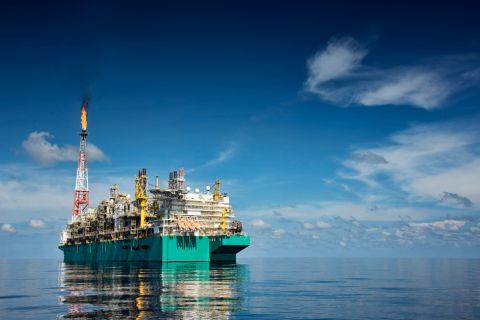In America, this means asking a question that gives one way more information than was expected. Perhaps the US National Petroleum Council has done just that.
I recently was invited to a meeting sponsored by the US National Petroleum Council (NPC) Supply Team Technology Subgroup that was examining the effect of seismic technology on this country's natural gas supplies. The idea is to host a series of these meetings over the next several months to gauge the effect of new technologies on the ability of the United States to meet its expected gas demand through the year 2025.
Perhaps the timing is bad; I don't know. But to ask the geophysical contracting industry anything about the future at this point is more likely to result in a shrug of shoulders than a meaningful discussion on its ability to meet future demand.
Let's face it, the industry has been hammered. It's easy to debate whose fault it is, but the underlying question is a little more difficult: Can geophysical contractors rise to the challenge of finding badly needed gas reserves when they've consistently lost money over the past several years?
James Ammer from the US Department of Energy (DOE) outlined some of the needs and challenges facing the industry. There's no question that the US still has vast natural gas reserves. But many of them are locked away in tight or very deep formations. And the new technologies that will be needed to find those reserves are less likely to be developed as research and development (R&D) spending has plummeted amongst the major oil companies. Additionally, many companies are risk-averse when it comes to trying new technologies, making it difficult to field-test new ideas.
The DOE, of course, is involved in several initiatives to help fund new research, and Ammer listed several tools that hold promise. Among these are a 400-level, three-component downhole seismic receiver array; a geomechanical modeling tool, a multi-attribute analysis tool; an anomalous velocity modeling tool; and improved nine-component, vertical seismic profiling and shear wave modeling capabilities.
But Ammer admitted that the funding available for these projects is minimal, calling into question the industry's ability to make them widely available.
Bjarte Fageraas from Input/Output presented the point of view from the seismic equipment manufacturers, which bear a significant portion of the research funding burden. Fageraas was not particularly optimistic, stating that most of the current focus on seismic acquisition improvements is environmental in nature, and there's little focus on signal and data quality. And while there have been significant improvements in acquisition equipment, he said there's a time lag between the availability of the equipment and its use.
In fact, many of the improvements tend to commoditize the equipment, resulting in less focus on quality and more focus on cost reduction. This lowers the barriers to entry, and the danger is that commodity-driven seismic acquisition will lead to "one-size-fits-all" surveys of questionable quality.
Craig Beasley, formerly with WesternGeco and now a Schlumberger fellow, painted a similarly bleak picture. Technology that can differentiate the high-tech geophysical contractors from their low-tech competitors includes techniques such as multicomponent seismic, time-lapse seismic, high-resolution seismic, integrated borehole and crosswell data, and smart fields, Beasley said. This type of data will be necessary as targets become more complex and harder to find. But he said the use of these techniques has not become commercial at anywhere near the rate or scale of 3-D seismic.
As a result, contractors have had to reduce their investment in R&D and prolong the use of current technologies. This may help the companies survive in the short term but does little to advance the technology in the long term.
Beasley's final comment related to 3-D seismic. "Would 3-D be developed in today's investment climate?" he asked. "I don't believe so." He added that it was not until the majors touted the benefits of the technology that the industry fully accepted 3-D. With the low risk tolerance prevalent in today's investment environment, fewer companies are willing to spend the time and money to investigate new techniques. "The contractors can't drag the industry there," Beasley said.
Overall, the group didn't forecast a particularly strong showing by seismic and imaging technology as aids to finding and developing more natural gas resources. Promising technologies abound. But without a longer-term focus by the oil industry that includes a dedication to developing these technologies, subsurface imaging is likely to remain a maddeningly inexact science.
Deep Shelf gets industry attention
On page 67, you'll find an article about the seismic challenges facing operators who are chasing deep gas targets on the Gulf of Mexico Outer Continental Shelf. Unfortunately, my deadline for that article came before an informative 2-day conference on the Deep Shelf hosted by The Energy Forum. The conference included a very interesting "town hall meeting" in which operators and geophysical contractors discussed the problems with current data over the area and the challenges and costs associated with acquiring new data.
I don't have the space to delve deeply into the discussion, but here are some of the high points.
• Contractors are reluctant to shoot higher-quality data, particularly multicomponent data, over the area because there's no demand for their products.
• Operators contend that until there are better interpretation products for multicomponent seismic, they're not interested in using it. Generally they want the vendors to provide products that are easy for them to use.
• The complexity of targets means that a "one-size-fits-all" type of multiclient seismic model is not likely to work here. Fit-for-purpose seismic is the way to go. But it's not cheap.
"Asking the contractor to supply us with the right data is a great goal, but it's just a dream," said one operator. "The processors cannot process the data to meet all of our needs.
"Cheap is great, but cheap is relative. We need to be willing to pay more to get the right seismic data."
Recommended Reading
Pembina Pipeline Enters Ethane-Supply Agreement, Slow Walks LNG Project
2024-02-26 - Canadian midstream company Pembina Pipeline also said it would hold off on new LNG terminal decision in a fourth quarter earnings call.
Canada’s Pembina Pipeline in No Rush to Invest in TMX
2024-05-14 - The Trans Mountain Pipeline’s toll structure has too much "uncertainty," said Pembina CFO Cameron Goldade on an earnings call.
Pembina Declares Series of Quarterly Dividends
2024-04-10 - Pembina Pipeline Corp’s board of directors declared quarterly dividends for series 1, 3, 5, 7, 9, 15, 17, 19, 21, 22 and 25.
ONEOK to Expand NGL Network Around Houston Through $280MM Acquisition
2024-05-13 - Easton Energy is agreeing to sell 450 miles of lines along Southeast Texas coast to ONEOK.
Canada’s First FLNG Project Gets Underway
2024-04-12 - Black & Veatch and Samsung Heavy Industries have been given notice to proceed with a floating LNG facility near Kitimat, British Columbia, Canada.





